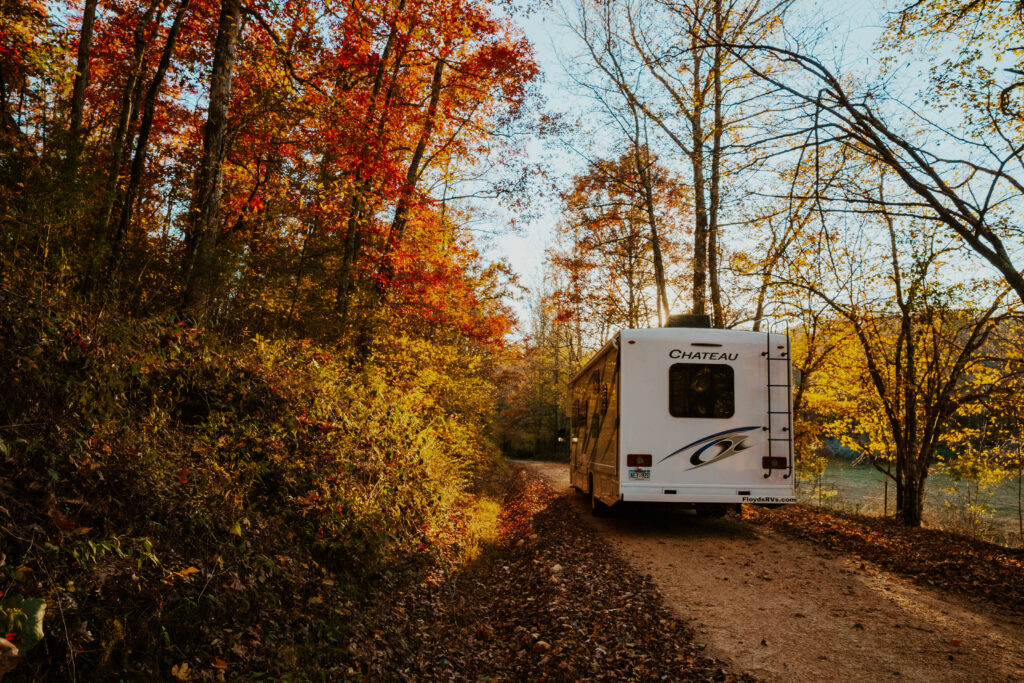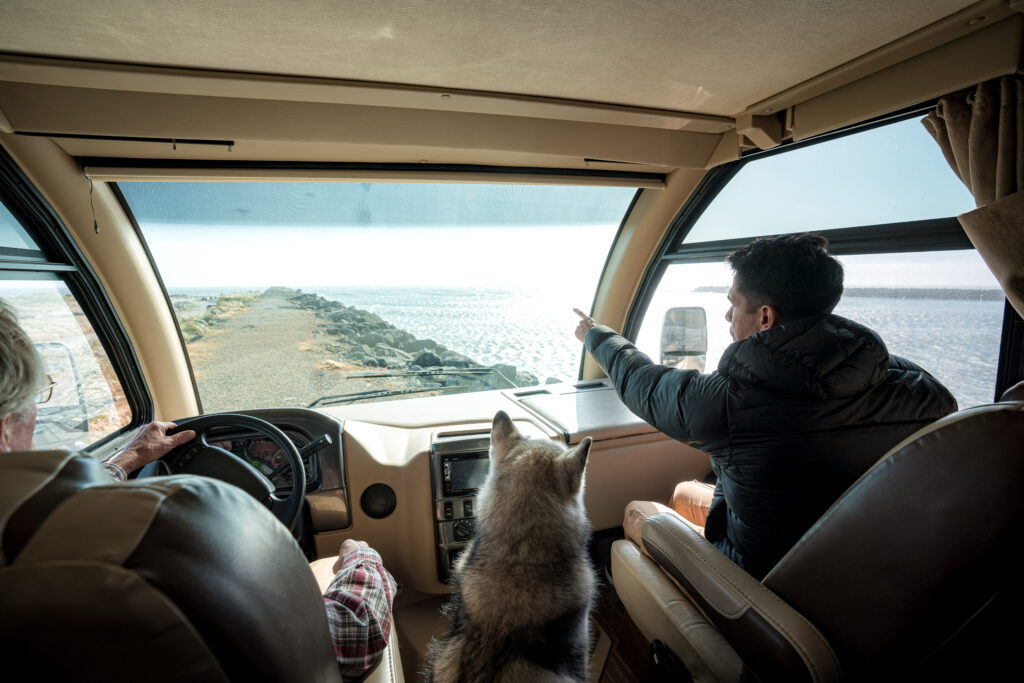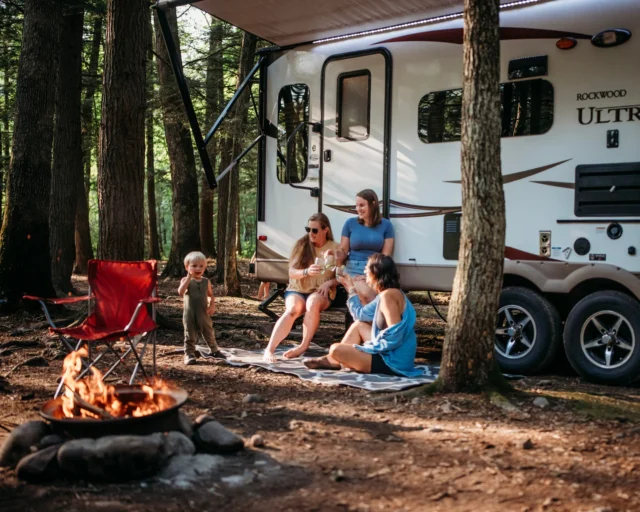
There are a lot of exciting parts of planning an RV road trip! Where to go … what to see … who to travel with … but you don’t want to neglect one of the most important parts of any road travel – your own safety and that of your passengers.
RV Seat Belt Laws
Seat belt laws vary widely from state to state, which can make things complicated if you’re traveling through several states or across the country. The easiest thing to do is abide by the state with the strictest laws, and then you’ll know you’re in good shape regardless of where you travel. With regard to RV seat belt laws, you can sit anywhere in your rig, however, that does not mean that all areas of an RV are the safest to ride.
RV Seat Belt Laws by State
All states now require the passengers and driver in the front of an RV to buckle up. New Hampshire does exempt models from 1968 or older, but everyone else up front needs to buckle up! Although it’s not a requirement in each of those states that the people in the back buckle up, it is certainly the safest way to travel!
The following states also require passengers besides those in the front to buckle up:
Alabama: Those in the back seat are not required, but remember to be smart and safe while traveling
Alaska: All passengers in the vehicle are required to wear a seat belt
Arizona: Children under 15 need to wear a seat belt in the back seats
Arkansas: All passengers in the vehicle are required to wear a seat belt
California: All passengers in the vehicle are required to wear a seat belt
Colorado: All passengers in the vehicle are required to wear a seat belt
Connecticut: Passengers in back seats who are under 16 are required to buckle up
Delaware: Every passenger in the vehicle must wear a seat belt
Florida: Passengers in the back who are under 18 are required to buckle up
Georgia: Passengers in the back under 18 are required to wear seat belts
Hawaii: Everyone in the vehicle is required to buckle up
Idaho: Everyone in an RV must wear a seat belt, but vehicles over 8,000 pounds are exempt from the rule
Illinois: All passengers 15 and under are required to wear seat belts in the back of a motorhome
Indiana: Backseat riders can sit without seatbelts while the vehicle is on the road
Iowa: All passengers (and the driver, of course!) must wear a seat belt when riding in an RV
Kansas: Children under 14 need to have a seat belt when riding in the back of an RV
Kentucky: Everyone is required to wear a seat belt when the RV is moving
Louisiana: Children under 12 are required to buckle up in the back seats of an RV
Maine: Everyone in the RV is required to wear a seat belt
Maryland: Adults in the backseat do not have to be buckled, but children should still be in seatbelts
Massachusetts: Everyone in the RV is required to wear a seat belt
Michigan: Children riding in the back who are under 15 are required to buckle up
Minnesota: Children ten and under are required to wear a seat belt in the back seats
Mississippi: Children ten and under are required to wear a seat belt in the back seats
Missouri: Children under 15 need to buckle up if they’re riding in the back seats
Montana: Everyone riding in an RV is required to wear a seat belt
Nebraska: Those under 18 need to buckle up in the back seats
Nevada: Everyone is required to wear a seat belt in an RV unless it is traveling at less than 15 miles per hour
New Hampshire: Everyone is required to wear a seat belt in an RV unless it is a 1968 or older model
New Jersey: Children 17 and under are required to buckle up in the back seats
New Mexico: All passengers must wear a seat belt
New York: Children under 15 are required to wear seat belts in the back seats
North Carolina: Children under 16 are required to wear seat belts in the back seats
North Dakota: Children under 17 are required to wear seat belts in the back seats
Ohio: Only front-seat riders need to buckle up, but it’s still safer to be buckled in regardless of where you’re sitting
Oklahoma: Children 12 and under are required to wear seat belts in the back seats
Oregon: Everyone is required to wear a seat belt in a moving RV
Pennsylvania: Children under 18 are required to wear seat belts in the back seats
Rhode Island: Everyone is required to wear a seat belt in a moving RV
South Carolina: Everyone is required to wear a seat belt in a moving RV
Tennessee: Children under 16 are required to wear seat belts in the back seats
Texas: Children 17 and under are required to wear seat belts in the back seats
Utah: Everyone is required to wear a seat belt in a moving RV
Vermont: Everyone is required to wear a seat belt in a moving RV
Virginia: Children 16 and under are required to wear seat belts in the back seats
Washington: Everyone is required to wear a seat belt in a moving RV
West Virginia: Children 17 and under are required to wear seat belts in the back seats
Wisconsin: Children 15 and under are required to wear seat belts in the back seats
Wyoming: Everyone is required to wear a seat belt in a moving RV

RV Seat Belt Requirements for Minors
As noted above, many RV seat belt requirements are based on the age of the children in your vehicle. Restrain children according to state laws, with younger children in car seats. Remember that child safety restraint systems should never be used in any rear-facing or bench-like seating.
Although the above lists the laws for children wearing seat belts in each state, the safest practice is to have everyone buckle up when your RV is in use. Seat belt laws represent the bare minimum of safety standards. They’re sometimes influenced by things like whether legislators think they can enforce these laws, and how willing people will be to follow them. Safety is only one of the considerations when passing laws.
Carseat Laws for RV Travel
Whether you’re traveling the country and road schooling your children, or you head out on weekend adventures with your family, there are many great ways to make memories when you travel by RV!
However, you also want to make sure your children are safe while you travel. Carseat laws and carseat safety are different for RVs than for standard vehicles.
You can find a list of states and their carseat laws HERE. Simply click on the state or states in which you are traveling to find out their requirements. If you’re driving through several states, you’ll want to abide by the strictest regulations and then you can be sure you’re in compliance in every state you visit.
Class A Motorhome Travel
A Class A motorhome is the large bus-style RV you may see traveling down the road. Class As have bathrooms, kitchens, bedrooms, and other conveniences. They usually also have a dinette and eating area and may have comfortable easy chairs or other seating in the main cabin. Class A motorhomes typically weigh between 13,000 to 30,000 lbs.
If your child is traveling in a Class A motorhome, most newer models have lap restraints installed in rear seats and dinettes. The lap restraints can be used by adults, and can also be used to attach car and booster seats while kids ride.
It may surprise you to know, however, that any vehicle weighing more than 10,000 pounds is not required to be crash-tested, so those vehicles don’t need to meet federal seat belt requirements. You’ll also want to make sure the seats you belt your child into are bolted directly to the frame – seats and cabinets in a dinette can often come apart in a crash, and it won’t matter if your child is seatbelted in if the seat itself is destroyed.
Class B Motorhome Travel
A Class B campervan is built, well, like a van. They weigh much less than Class As, typically between 6,000 and 11,000 lbs. This means they are, for the most part, subject to federal seat belt laws and standards. You can safely install a carseat in back passenger seats in a Class B van, and many rear sofas and dinettes also have lap belts you can use. If you are renting or purchasing a van, you’ll want to check the seats, however, to make sure the owner didn’t take out any seats to make room for appliances or other features. Make sure you have safe seating for everyone who will be traveling with you.
Also, don’t install a carseat on a side or rear-facing bench.
Class C Motorhome Travel
Class C campers are often recognized as the Goldilocks of motorhomes. They’re just the right size – not as big as a Class A RV, but with more room than a Class B campervan. Class Cs are built on a truck chassis, but they are often over 10,000 pounds. If they do weigh more, they’re not required to pass the federal seat belt standard.
A Class C with a crew cab featuring back seats like a pickup are the safest place for a child’s carseat. Check your camper to make sure any seat belts are attached to the chassis frame itself and not just to the bench seats, and only place children in forward-facing seats.
Travel Trailer Carseats
Since fifth wheels, teardrop campers, and other travel trailers all require a tow vehicle, that vehicle will have been crash tested and will meet federal seat belt standards. These vehicles are one of the safest places in a crash, both because of the higher standards and because there are fewer items in the vehicle that can fly around during a crash and injure someone.

Other ways to keep children safe
There are a few other ideas to keep your children safe while you travel.
- Choose a non-motorized towable like a teardrop camper or fifth-wheel trailer, as this is safer than a coach. Children can be restrained properly in the passenger vehicle that is towing the RV.
- If using a coach, drive a second car for the children to ride in, so that the children are restrained properly. This has the added bonus of giving you a vehicle to travel around your destination once you’ve set up your motorhome.
- Have custom seats built into your RV that meet federal seat belt standards, for strapping your children in.
RV seat belt standards according to class of RV
Whether you have a Class A, Class C, or Class B RV, keep in mind that, manufacturers are ONLY required to comply with seat belt standards for the front passengers, not any rear occupants that may be traveling in the rig.
False sense of security
Many RV seats have lap belts in the dining section of the RV. Though these seat belts are usually bolted to the floor, the biggest concern with these belts is that the wooden seat structure, on which the passenger is sitting, will fail and cause injury in the event of an accident. Furniture and appliances all around the RV can also fall over the passenger trapped in the seating.
Remember, sideways seats are not designated travel seats. Front-facing seats are the safest to travel in. Also, keep in mind that each manufacturer has different ways of testing their seat belts, and there are no defined industry standards for these tests.

Driving Laws All RVers Should Know
American driving laws do vary by state, especially when you’re driving a very large and heavy vehicle like an RV or towing a trailer. And although you might barely notice that you’ve crossed a state border when you’re on a long trip, the change in the driving laws might mean you end up with a pricey ticket to pay… all for breaking a law you knew nothing about.
Nobody wants to factor traffic tickets into their travel budget. So here are a few US driving and road traffic laws that RVers should know about.
RV Driving Regulations
Let’s start with the good news: There are a few laws that are universal!
For example, always obey all posted signs and speed limits. If you’re wondering about right turn lane rules, it’s legal to make a right on red unless otherwise posted… although when you’ve got such a long vehicle, you’ll want to proceed with lots of caution.
Other laws that apply to all drivers vary from state to state. For instance, many cities have begun to incorporate distracted driving laws into their legal code, which make it illegal to do things like texting while driving. (Even if you’re in a place where that is legal, it’s never a good idea, no matter what you’re driving!)
There are also laws that more specifically pertain to RVs and RV driving. For instance, if you’re driving a motorcoach (where passengers can move freely inside the RV while underway), you’ll want to know the relevant RV seat belt laws, which can vary by state. If you have alcohol on board (for example, in your RV’s refrigerator), you’ll also want to check up on open container laws. In many states, it’s legal to have an open container of alcohol in the vehicle because it’s technically a domicile, but it’s a good idea to ensure it’s not within the driver’s reach.
Another issue that is important to many RVers is firearm ownership. Owning a firearm is federally allowed by the U.S. Constitution, but the rules and regulations pertaining to how, when, and where you may carry a firearm vary by state. You may need a permit in some states in order to have a weapon in your vehicle, even if it’s unloaded and cased.

Towing Laws
Towing has its own set of intricacies and complications, specifically revolving around travel trailer lengths and weights in different states. For instance, here are a few specific laws for travel trailers, according to TripSavvy:
- In Alabama, travel trailers cannot be longer than 40 feet
- In Alabama, Arizona, Washington D.C., Georgia, Illinois, Kentucky, Louisiana, Michigan, Missouri, New Hampshire, New Jersey, New Mexico, New York, Oklahoma, and Tennessee, travel trailers cannot be wider than 8 feet
- Connecticut limits RVs to 7.5 feet in width, 8 feet in height, 24 feet in length, and 7,300 pounds in weight on the Merritt and Wilbur Parkways
In addition, some states require extra equipment and special brakes for towed vehicles over a certain weight. Utah requires a breakaway braking system if your trailer is over 3,000 pounds, and North Carolina requires an independent brake system for house trailers that weigh 1,000 pounds or more.
Additionally, you may find yourself stuck if you have a full tank of propane on board and need to pass through a large tunnel, such as the Baltimore Harbor Tunnel in Maryland. And some states have special motorhome license requirements if your rig is over a certain length or weight.
No matter where you’re going, it’s imperative to figure out the laws in each state before you hit the road, so you don’t find yourself in a sticky situation. Fortunately, the internet makes this a lot easier than it used to be — you can simply look everything up online.
You’ll also want to have your route planned to make sure you’ll meet all the clearance requirements. You can map out your drive to avoid bridges and tunnels with weight or height restrictions where you won’t fit. Invest in a quality RV GPS system, since they can be programmed to avoid those restrictions.
(And, hey, even if you’re old school… grab that atlas of yours and get a pencil. You’ll thank yourself when you’re not headed toward a low-clearance tunnel at 60 miles per hour!)
With a little research, you can be sure that you’re complying with the laws for seatbelts and safe RV travel in each state!






